-

新人教版高中英语必修3Unit 1 Festivals and Celebrations-Reading for writing教学设计二
Step 3 Analyzing article structureActivity 31. Teachers raise questions to guide students to analyze the chapter structure of this diary and think about how to describe the festival experience. (1)What should be included in the opening/body/closing paragraph(s)?(2)How did the writer arrange his/her ideas?(3)What kind of interesting details did the writer describe?(4)How did the writer describe his/her feelings/emotions during the event?2. Students read and compare the three sentence patterns in activity 2. Try to rewrite the first paragraph of the diary with these three sentence patterns. After that, students exchange corrections with their partners. Such as:●This was my first time spending three days experiencing the Naadam Festival in China’s Inner Mongolia Autonomous Region and it was an enjoyable and exciting experience. ●I'll never forget my experience at the Naadam Festival because it was my first time to watch the exciting Mongolian games of horse racing, wrestling, and archery so closely. ●I'll always remember my first experience at the Naadam Festival in China’s Inner Mongolia Autonomous Region because it was so amazing to spend three days witnessing a grand Mongolian ceremony. Step 4 Accumulation of statementsActivity 41. Ask the students to read the diary again. Look for sentences that express feelings and emotions, especially those with the -ing form and the past participle. Such as:● …horse racing, wrestling, and archery, which are all so exciting to watch. ● some amazing performances● I was surprised to see…● I was a little worried about. . . ● feeling really tiredOther emotional statements:●I absolutely enjoyed the archery, too, but the horse races were my favourite part. ●I'm finally back home now, feeling really tired, but celebrating Naadam with my friend was totally worth it. ●He invited me back for the winter to stay in a traditional Mongolian tent and cat hot pot. I can’t wait!2. In addition to the use of the -ing form and the past participle, the teacher should guide the students in the appreciation of these statements, ask them to memorize them, and encourage them to use them reasonably in writing practice.
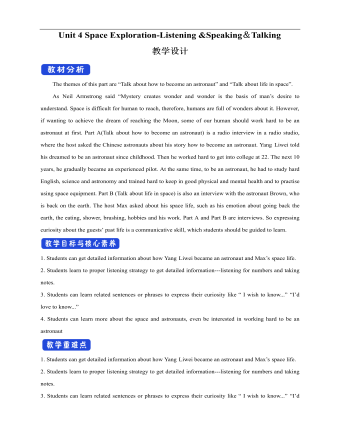
新人教版高中英语必修3Unit 4 Space Exploration-Listening&Speaking&Talking教学设计二
The themes of this part are “Talk about how to become an astronaut” and “Talk about life in space”. As Neil Armstrong said “Mystery creates wonder and wonder is the basis of man’s desire to understand. Space is difficult for human to reach, therefore, humans are full of wonders about it. However, if wanting to achieve the dream of reaching the Moon, some of our human should work hard to be an astronaut at first. Part A(Talk about how to become an astronaut) is a radio interview in a radio studio, where the host asked the Chinese astronauts about his story how to become an astronaut. Yang Liwei told his dreamed to be an astronaut since childhood. Then he worked hard to get into college at 22. The next 10 years, he gradually became an experienced pilot. At the same time, to be an astronaut, he had to study hard English, science and astronomy and trained hard to keep in good physical and mental health and to practise using space equipment. Part B (Talk about life in space) is also an interview with the astronaut Brown, who is back on the earth. The host Max asked about his space life, such as his emotion about going back the earth, the eating, shower, brushing, hobbies and his work. Part A and Part B are interviews. So expressing curiosity about the guests’ past life is a communicative skill, which students should be guided to learn.1. Students can get detailed information about how Yang Liwei became an astronaut and Max’s space life.2. Students learn to proper listening strategy to get detailed information---listening for numbers and taking notes.3. Students can learn related sentences or phrases to express their curiosity like “ I wish to know...” “I’d love to know...”4. Students can learn more about the space and astronauts, even be interested in working hard to be an astronaut
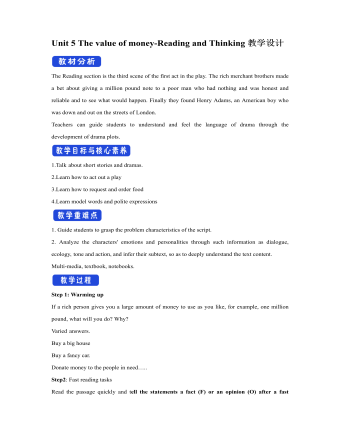
新人教版高中英语必修3Unit 5 The value of money-Reading and Thinking教学设计二
? Could you offer me some kind of work here?? I don’t want your charity, I just want an honest job.? Careless: I landed in Britain by accident.Step 7:Consolidation.? Find Henry? Roderick and Oliver were I .making a bet when they saw Henry, a poor young man. ? Know Henry? About a month ago, Henry was sailing and later he found himself carried out to sea by a strong wind. Fortunately, he 2.was spotted by a ship. And it was the ship that brought him to 3.England? Offer money to Henry ? Oliver and Roderick gave Henry a letter and told him that there was money in it. They 4.persuaded him to accept it, and made him 5.promise that it wouldn't be opened until 2 o'clock.Step 8:Language pointsa large amount of: a large quantity of; a great deal ofe.g. They bought a large amount of furniture before they moved their new house.make a bet: make an arrangement to risk money, etc. on an event of which the result is doubtful.e.g. We made a bet on the result of the match.permit sb to do something: allow somebody to do somethinge.g. My mother doesn’t permit me to ride in the street after it rained.by accident: as a result of chancee.g. I only found it by accident.stare at: look at somebody or something with the eyes wide open in a fixed gaze( in astonishment, wonder, fear, etc)to be honest: to tell you the truth; to be franke.g. To be honest, I don’t think we have a chance of winning.Step7 Homework:What do you think will happen to Henry? Will the bank-note help him or get him into trouble?
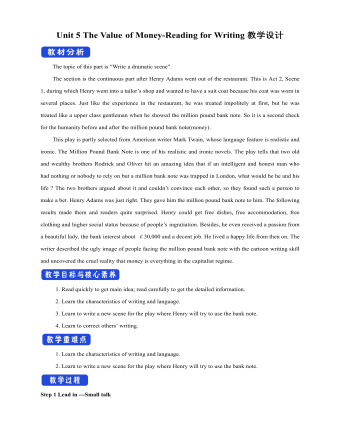
新人教版高中英语必修3Unit 5 The Value of Money-Reading for Writing教学设计二
2. 您能看到, 我头发太长了。You can see that my hair is much too long.3. 无论什么时候, 只要您想回来就回来。Please come back whenever you want.4. 您仅有很少的头发要理! You only have too little hair to cut !5. 为您服务是我的荣幸!It is my honour to serve you!Step 9 Writing(Henry is walking down the street when he sees a sign for a place that cuts hair. He decides to have it cut. )H=Henry B=BarberH: Good afternoon, I’d like to have my hair cut, if I may. (The barber looks at Henry’s hair and continues cutting another man’s hair. ) Er, I’d really like a haircut. As you can see it’s much too long. B: (in a rude manner) Yes, I can see that. Indeed, I can. H: Fine, well, I’ll have a seat then. (He sits in one of the barber’s chairs. The barber turns to look at Henry. )B: It’s quite expensive here, you know! Are you sure you can afford it?H: Yes. I think so. (After his hair is cut, the barber tells Henry how much he must pay. Henry shows the barber the bank note. )B: Why Mr. . . (looks shocked)H: Adams. Henry Adams. I’m sorry. I don’t have any change. B: Please don’t worry! (wearing a big smile) Nothing to worry about! Nothing at all! Please come back whenever you want, even if you only have too little hair to cut! It will be my honour to serve you!Step 10 Pair workExchange drafts with a partner. Use this checklist to help your partner revise his/her draft.1. Are all the elements of a play included and in good order ?2. Do the character use suitable language ?3. Are the stage directions clear and useful ?4. Is the plot clear and exciting enough ?
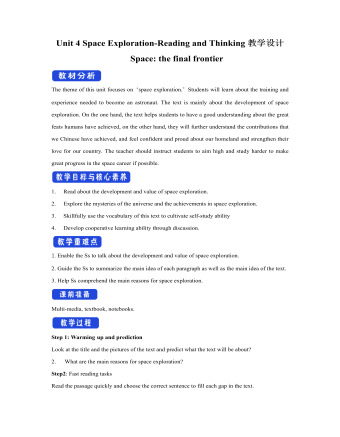
新人教版高中英语必修3Unit 4 Space Exploration-Reading and Thinking教学设计二
The theme of this unit focuses on “space exploration.” Students will learn about the training and experience needed to become an astronaut. The text is mainly about the development of space exploration. On the one hand, the text helps students to have a good understanding about the great feats humans have achieved, on the other hand, they will further understand the contributions that we Chinese have achieved, and feel confident and proud about our homeland and strengthen their love for our country. The teacher should instruct students to aim high and study harder to make great progress in the space career if possible.1. Read about the development and value of space exploration.2. Explore the mysteries of the universe and the achievements in space exploration.3. Skillfully use the vocabulary of this text to cultivate self-study ability 4. Develop cooperative learning ability through discussion.1. Enable the Ss to talk about the development and value of space exploration.2. Guide the Ss to summarize the main idea of each paragraph as well as the main idea of the text.3. Help Ss comprehend the main reasons for space exploration. Multi-media, textbook, notebooks.Step 1: Warming up and predictionLook at the title and the pictures of the text and predict what the text will be about?2. What are the main reasons for space exploration?
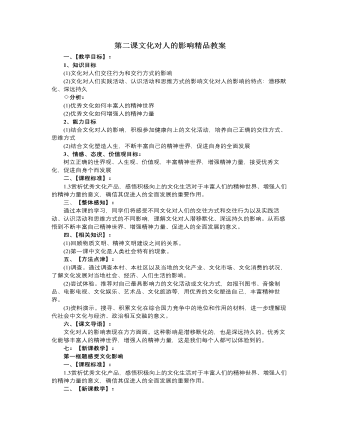
人教版高中政治必修3第二课文化对人的影响精品教案
民族精神是一个民族赖以生存和发展的精神支撑。一个民族,没有振奋的精神和高尚的品格,不可能自立于世界民族之林。“铁人”精神是“爱国、创业、求实、奉献”的大庆精神的典型化、人格化。其主要方面包括:“为祖国分忧、为民族争气”的爱国主义精神;为“早日把中国石油落后的帽子甩到太平洋里去”,“宁肯少活二十年,拼命也要拿下大油田”的忘我拼搏精神;干事业“有条件要上,没有条件创造条件也要上”的艰苦奋斗精神;“要为油田负责一辈子”,“干工作要经得起子孙万代检查”,对工作精益求精,为革命“练一身硬功夫、真本事”的科学求实精神;不计名利,不计报酬,埋头苦干的“老黄牛”精神;等等。40多年来,“铁人”精神早已家喻户晓,深入人心,成为大庆人的共同理想、信念和行为准则。“铁人”精神是对王进喜崇高思想、优秀品德的高度概括,体现了我国工人阶级精神风貌和中华民族传统美德的完美结合。“铁人”精神是战胜困难、勇往直前、不断取得新胜利的巨大精神力量。“铁人”精神是我们强大的精神支柱。
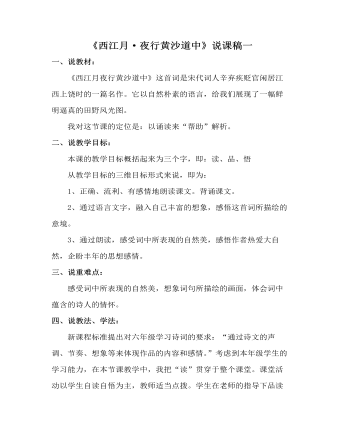
部编人教版六年级上册《古诗词三首:西江月·夜行黄沙道中》说课稿
一、说教材:《西江月夜行黄沙道中》这首词是宋代词人辛弃疾贬官闲居江西上饶时的一篇名作。它以自然朴素的语言,给我们展现了一幅鲜明逼真的田野风光图。我对这节课的定位是:以诵读来“帮助”解析。二、说教学目标:本课的教学目标概括起来为三个字,即:读、品、悟从教学目标的三维目标形式来说,即为:1、正确、流利、有感情地朗读课文。背诵课文。2、通过语言文字,融入自己丰富的想象,感悟这首词所描绘的意境。3、通过朗读,感受词中所表现的自然美,感悟作者热爱大自然,企盼丰年的思想感情。三、说重难点:感受词中所表现的自然美,想象词句所描绘的画面,体会词中蕴含的诗人的情怀。四、说教法、学法:新课程标准提出对六年级学习诗词的要求:“通过诗文的声调、节奏、想象等来体现作品的内容和感情。”考虑到本年级学生的学习能力,在本节课教学中,我把“读”贯穿于整个课堂。
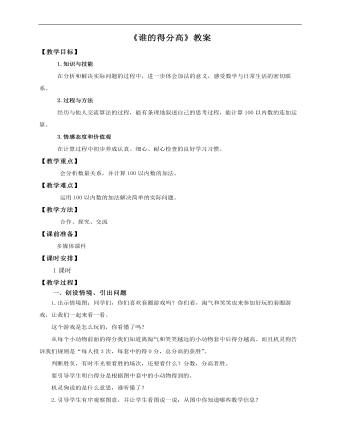
小学数学北师大版二年级上册《第一课谁的得分高》教案说课稿
2.过程与方法经历与他人交流算法的过程,能有条理地叙述自己的思考过程,能计算100以内数的连加运算。3.情感态度和价值观在计算过程中初步养成认真、细心、耐心检查的良好学习习惯。【教学重点】 会分析数量关系,并计算100以内数的加法。【教学难点】 运用100以内数的加法解决简单的实际问题。【教学方法】 合作、探究、交流【课前准备】 多媒体课件【课时安排】 1课时【教学过程】一、创设情境、引出问题1.出示情境图:同学们,你们喜欢套圈游戏吗?你们看,淘气和笑笑也来参加好玩的套圈游戏,让我们一起来看一看。这个游戏是怎么玩的,你看懂了吗?从每个小动物前面的得分我们知道离淘气和笑笑越远的小动物套中后得分越高。而且机灵狗告诉我们规则是“每人投3次,每套中的得0分,总分高的获胜”。判断胜负,有时不光要看胜的场次,还要看什么?分数,分高者胜。要引导学生明白得分是根据图中套中的小动物得到的。机灵狗说的是什么意思,谁听懂了?2.引导学生有序观察图意,并让学生看图说一说:从图中你知道哪些数学信息?
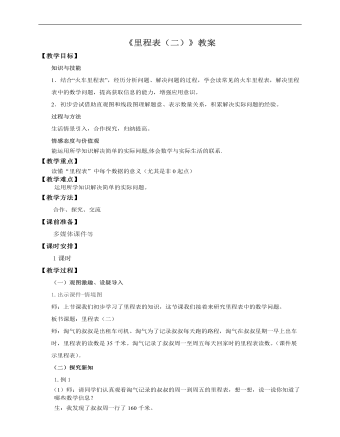
小学数学北师大版三年级上册《第五课里程表(二)》教案说课稿
(一)观图激趣、设疑导入 1.出示课件-情境图师:上节课我们初步学习了里程表的知识,这节课我们接着来研究里程表中的数学问题。板书课题:里程表(二)师:淘气的叔叔是出租车司机。淘气为了记录叔叔每天跑的路程,淘气在叔叔星期一早上出车时,里程表的读数是35千米。淘气记录了叔叔周一至周五每天回家时的里程表读数。(课件展示里程表)。(二)探究新知1.例1(1)师:请同学们认真观看淘气记录的叔叔的周一到周五的里程表,想一想,说一说你知道了哪些数学信息?生:我发现了叔叔周一行了160千米。 师:同学们他说找到数学信息对吗?生:160千米不是星期一的行驶里程,应该是星期一晚上里程表上的读数。 星期二里程表上的读数是350,。生:。。。。师:同学们找的数学信息非常多,非常全面。(2)小组讨论交流:淘气根据题意画了一个图,你看懂了吗?与同伴说一说。
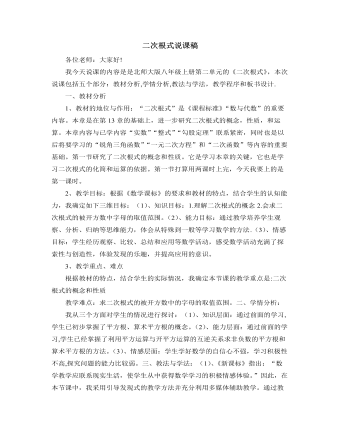
北师大版初中八年级数学上册二次根式说课稿
有意义,字母x的取值必须满足什么条件?设计意图:通过例题的讲解,使学生加深对所学知识的理解,避免一些常见错误。而变式练习设计,延续的例题的风格,一步一步,步步深入,本节课的教学难点就在学生的操作活动中迎刃而解了。对提高学生对所学知识的迁移能力和应用意识,激发好奇心和求知欲起到良好效果。(五)、巩固运用,提高认识1、通过基础训练让学生体验学习的成就感。2、应用拓展:增加难处,再次让学生联系以前的知识,增强学生的数学应用意识。(六)、总结评价,质疑问难这节课我们学习了什么?设计意图:学生共同总结,互相取长补短,学生在畅所欲言中对二次根式的认知得到进一步的巩固升华。五、板书设计.采用纲领式的板书,使学生有“话”可说,有“理”可循,在简单板书设计中使学生体会到数学的简洁美。
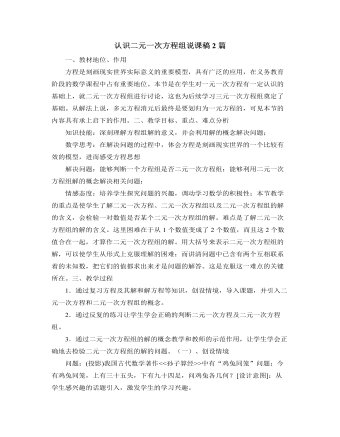
北师大版初中八年级数学上册认识二元一次方程组说课稿2篇
我们遇到的往往就是这样的方程组,我们要想比较简捷地把它解出来,就需要转化为同一个未知数系数相同或相反的情形,从而用加减消元法,达到消元的目的.请大家把解答过程写出来.解:①×3,得:6936xy??,③②×2,得:3486??yx,④③-④,得:2?y.将2?y代入①,得:3?x.根据上面几个方程组的解法,请同学们思考下面两个问题:(1)加减消元法解二元一次方程组的基本思路是什么?(2)用加减消元法解二元一次方程组的主要步骤有哪些?(由学生分组讨论、总结并请学生代表发言)[师生共析](1)用加减消元法解二元一次方程组的基本思路仍然是“消元”.(2)用加减法解二元一次方程组的一般步骤是:①变形----找出两个方程中同一个未知数系数的绝对值的最小公倍数,然分别在两个方程的两边乘以适当的数,使所找的未知数的系数相等或互为相反数.②加减消元,得到一个一元一次方程.③解一元一次方程.
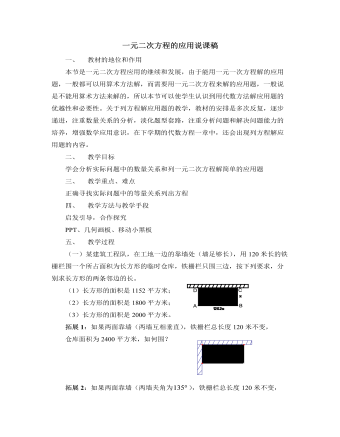
北师大版初中数学九年级上册一元二次方程的应用说课稿
(三)如图, 中, ,AB=6厘米,BC=8厘米,点 从点 开始,在 边上以1厘米/秒的速度向 移动,点 从点 开始,在 边上以2厘米/秒的速度向点 移动.如果点 , 分别从点 , 同时出发,经几秒钟,使 的面积等于 ?拓展:如果把BC边的长度改为7cm,对本题的结果有何影响?(四)本课小结列方程解应用题的一般步骤:1、 审题:分析相关的量2、 设元:把相关的量符号化,设定一个量为X,并用含X的代数式表示相关的量3、 列方程:把量的关系等式化4、 解方程5、 检验并作答(五)布置作业1、请欣赏一道借用苏轼诗词《念奴娇·赤壁怀古》的头两句改编而成的方程应用题, 解读诗词(通过列方程,算出周瑜去世时的年龄)大江东去浪淘尽,千古风流数人物,而立之年督东吴,早逝英年两位数,十位恰小个位三,个位平方与寿符,哪位学子算得快,多少年华属周瑜?本题强调对古文化诗词的阅读理解,贯通数学的实际应用。有两种解题思路:枚举法和方程法。
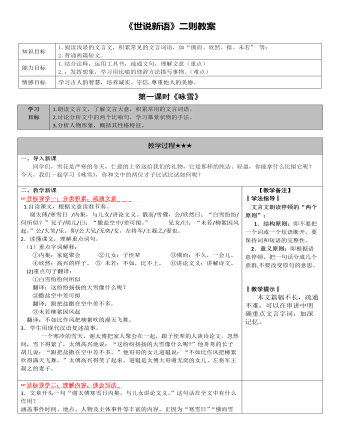
部编版语文七年级上册《世说新语》二则教案
?目标导学二:理解内容,体会写法 1.文章开头一句“谢太傅寒雪日内集,与儿女讲论文义。”这句话在全文中有什么作用? 涵盖事件时间、地点、人物及主体事件等丰富的内容。正因为“寒雪日”“俄而雪骤”,才能引出“咏雪。2.“寒雪”“内集”“欣然”“大笑”’等词语营造了一种怎样的家庭氛围?营造了一种融洽、欢快、轻松的家庭氛围。3.“咏雪”的过程中,文章特别记载了两个人的咏,即用“撒盐空中”和“柳絮因风起”来比拟“大雪纷纷”,你对其中哪一个更欣赏?为什么?“柳絮因风起”更好,因为柳絮比盐更像雪。给人以春天即将到来的感觉,意蕴强,有美感,这是“撒盐空中”所缺乏的。“撒盐空中”比喻了雪的颜色。 4.文章结尾交待了谢道韫的身份,有什么用意?谢太傅对两人的答案未做评定,只是“大笑乐”而已,十分耐人寻味。作者也没有表态,却在最后补充了道韫的身份,这是一个有力的暗示,表明他赞赏道韫的才气。
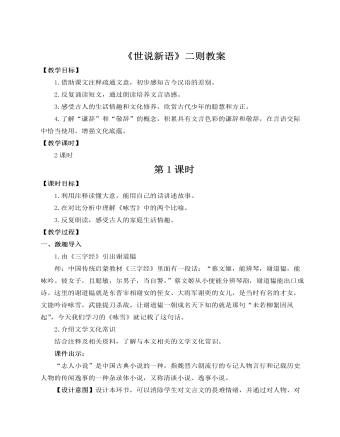
人教部编版七年级语文上册《世说新语》二则教案
“志人小说”中的“志人”这个名称,是鲁迅从“志怪”推衍出来的。“志人”这个名目,为鲁迅《中国小说的历史的变迁》所设立,与“志怪”相对而言。《中国小说史略》又说:“记人间事者已甚古,列御寇韩非皆有录载,惟其所以录载者,列在用以喻道,韩在储以论政。若为赏心而作,则实萌芽于魏而盛大于晋,虽不免追随俗尚,或供揣摩,然要为远实用而近娱乐矣。”这里提出的观点很重要,即所谓志人小说,其写作目的,虽仍有记录史实、供人揣摩的考虑,但欣赏和娱乐的特点已经很强。志人小说在数量上仅次于志怪小说,是在品藻人物的社会风气影响之下形成的。魏晋南北朝的志人小说的艺术特点有以下四个方面:一是以真人真事为描写对象;二是以“丛残小语”、尺幅短书为主要形式;三是善于运用典型细节描写和对比衬托手法,突出刻画人物某一方面的性格特征;四是语言简练朴素,生动优美,言约旨丰。这些艺术特点对后世小说产生了很大影响。
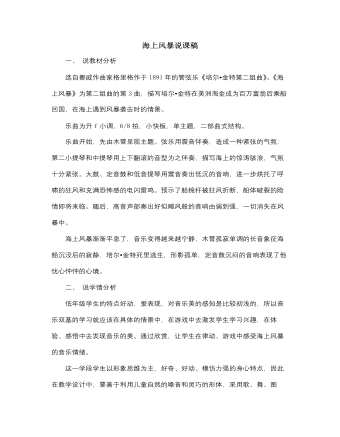
人音版小学音乐二年级上册海上风暴说课稿
[设计意图:通过这一环节,学生参与到《海上风暴》表演中,感受大海,对大海进行了全面的认识,更让学生明白了遇到困难要团结,团结力量大]你们真勇敢,经过我们的共同努力终于战胜了风暴,迎来了晴天(课件说明:出示图片平静的大海,小船在海面上静静地移动,并以歌曲《海》作为背景音乐)四、演绎大海的歌1、师:今天我们感受了平静的大海,欣赏了有风暴的大海,你喜欢怎样的海?2、教师听学生的各种说法及理由之后,说:那就让我们一起来体会一下不同的海吧。(学生感觉像是坐上一艘大船,听音乐表演,听到平静的大海的音乐就根据伴奏音乐表演并歌唱《海》,听到有风暴的海的音乐就用表情和身体动作来表现。)3、朋友们,你们的海之旅收获还真不少呀,通过此次旅行,我想每一位小朋友都有一个自己心中的大海,希望小朋友们在课后,把你心中的大海表演给爸爸妈妈看。

人音版小学音乐二年级上册小拜年说课稿
打击乐器是小学生喜欢的乐器。让学生在音乐课上演奏打击乐器,不但可以提高学生的学习兴趣,同时也能培养对音乐的感知力。让学生为乐曲加上打击乐器伴奏。在鼓、钹声中,学生的参与意识被激发。加强了学生对音乐的理解,增强了音乐的表现力。(五)拓展延伸 。 1、让音乐与生活沟通起来音乐本来就是从生活中创造出来的。我们在音乐教学过程中根据教学需要,实现教师、学生、教材、教具、教学环境与生活的多方面横向联系,及他们之间的相互作用和影响。 (六)、课堂小结。课堂小结:是在完成某项教学任务的终了阶段,教师富有艺术性的对所学知识和技能进行归纳、总结和升华的行为方式,它常用于课堂的结尾,所以形象地被称作"豹尾"。完善、精要的"小结",可以使课堂教学锦上添花,余味无穷,让学生达到前后浑然一体的美妙境界,以激发学生学习音乐课的热情,同时性情也受到熏陶。
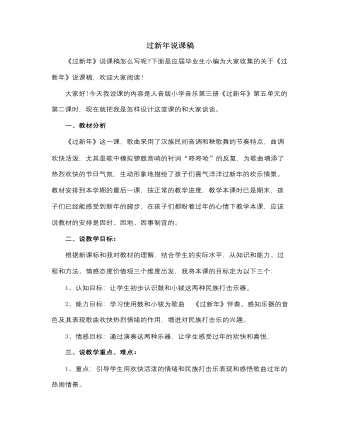
人音版小学音乐二年级上册过新年说课稿
经过“十”字步的学习知道东北秧歌的基本步伐。8、 演一演 让孩子们用舞蹈表现歌曲,拿起手帕扭秧歌、以及用打击乐器为歌曲进行伴奏,演示一遍,把全课推向高潮。七、教学启示总之,在本方案的设计中,我力求体现以人为本的思想,着眼于学生的主动发展,致力于运用现代信息技术优化课堂教学的研究,淡化学科边缘,通过充分的音乐实践培养学生的能力,提高音乐素养。依托音乐本身的魅力,影响学生人生观、审美观、价值观的形成。全面影响学生做人、做事的态度,培养学生主动学习、合作意识、探究精神。从目标的提出、到过程的安排、学习方法的确定、乃至学习成果的呈现,都让学生有更大的自主性、更多的实践性、更浓的创造性。当然,措施付诸实施,还需要老师的爱心和慧心,教学研究永无止境,我相信,没有最好,只有更好。在此,还请各位领导和同行们提出宝贵意见,谢谢!
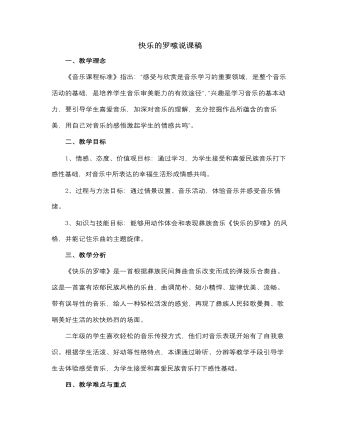
人音版小学音乐二年级上册快乐的罗嗦说课稿
一、教学理念《音乐课程标准》指出:“感受与欣赏是音乐学习的重要领域,是整个音乐活动的基础,是培养学生音乐审美能力的有效途径”,“兴趣是学习音乐的基本动力,要引导学生喜爱音乐,加深对音乐的理解,充分挖掘作品所蕴含的音乐美,用自己对音乐的感悟激起学生的情感共鸣”。二、教学目标1、情感、态度、价值观目标:通过学习,为学生接受和喜爱民族音乐打下感性基础,对音乐中所表达的幸福生活形成情感共鸣。2、过程与方法目标:通过情景设置、音乐活动,体验音乐并感受音乐情绪。3、知识与技能目标:能够用动作体会和表现彝族音乐《快乐的罗嗦》的风格,并能记住乐曲的主题旋律。三、教学分析《快乐的罗嗦》是一首根据彝族民间舞曲音乐改变而成的弹拨乐合奏曲。这是一首富有浓郁民族风格的乐曲,曲调简朴、短小精悍、旋律优美、流畅。
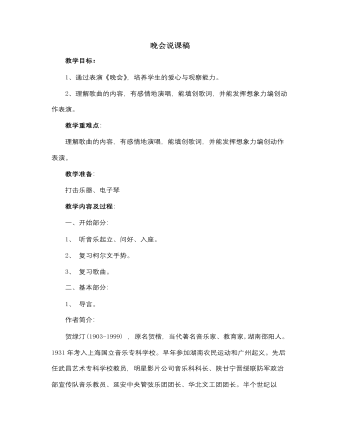
人音版小学音乐二年级上册晚会说课稿
原名《闹新年》,是贺绿汀在1934年创作的一首钢琴曲,1940年改编为管弦乐曲,并通过电台对苏联播出,深获好评。1943年作者在延安对乐曲作了修改。1949年作者把自己的六首作品编成一部管弦乐组曲,《晚会》为其中一首。乐曲如标题所示,描绘了人们欢天喜地举行晚会庆祝胜利的情景。全曲共分为六段,后三段是前三段的反复。在第三段中,作者巧妙地运用了中国民间锣鼓的节奏,使欢乐的情绪达到高潮。2、 表演《晚会》(1) 完整地聆听歌曲,用手指随着课本上的旋律滑动。(2) 听着歌曲录音跟唱全曲。(3) 分组进行编创活动。提示:利用小组的智慧你一句,我一句为歌曲编创新歌词,分组表演自己的歌。(4) 边唱边表演动作。第一段唱原词,第二段唱小组填创的歌词。(5) 背唱自创的歌曲表演《过新年》给爸爸、妈妈听。(6) 聆听《晚会》初听音乐,感受音乐的欢乐氛围。提示;音乐让你想到了什么?心情是怎样的?
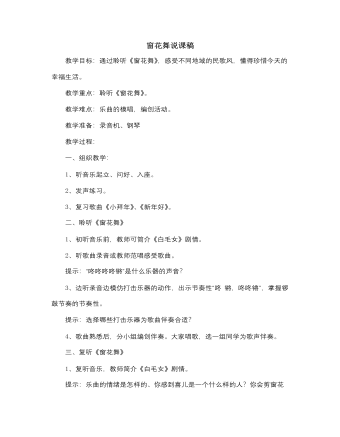
人音版小学音乐二年级上册窗花舞说课稿
3、我们知道舞蹈是舞剧的一个重要表现形式,接下来我们通过下面这段视频来想想,舞剧还有哪些表现形式呢?(播放《快乐的女战士》,老师用不同的方式来播放。)舞剧音乐有什么作用?【用有声和无声两种方式播放《快乐的女战士》,学生对比说出舞剧音乐作用,渲染、烘托舞台气氛】4、同学们现在我们知道了舞剧是一种以舞蹈为主要表现手段,综合音乐、美术、文学等艺术形式,表现特定的人物和一定戏剧情节的舞台表演艺术。艺术表现形式还有歌剧、话剧【学生能说出是以舞蹈为主,教师总结舞剧的概念】六、课堂小结:今天,我们欣赏了芭蕾舞剧《窗花舞》,也了解了什么是舞剧、舞剧所包括的艺术形式。我们只欣赏了几部经典歌剧的片段,国内外还有许多非常著名的芭蕾舞剧,希望同学们回家在网上搜集一下欣赏完整的经典芭蕾舞剧!感受这一世界奇葩的魅力!
